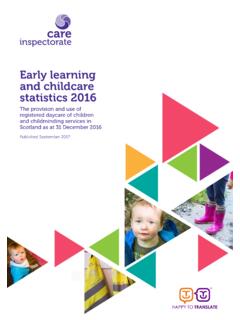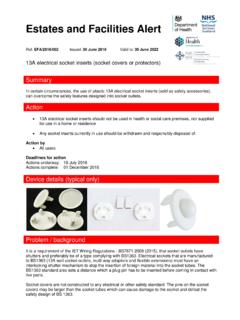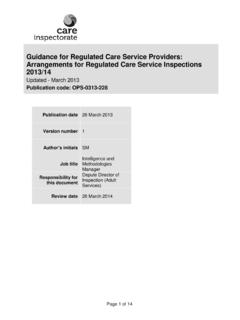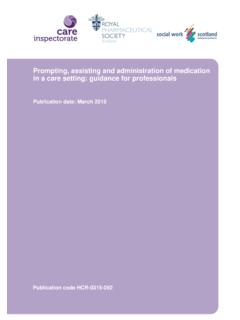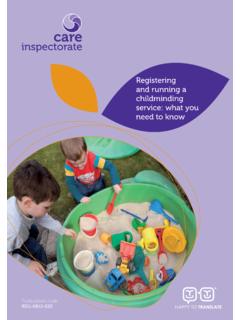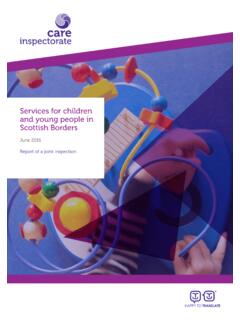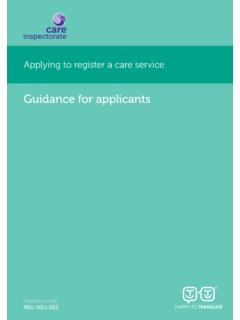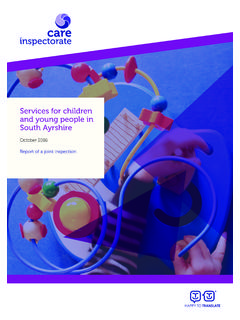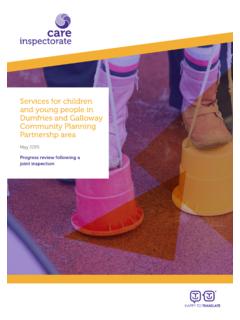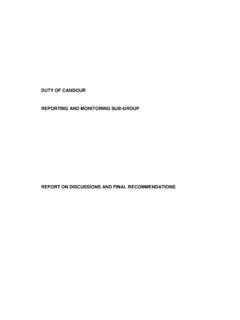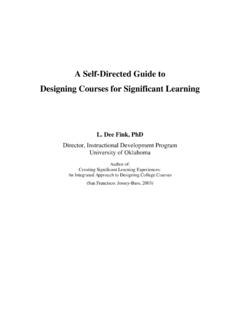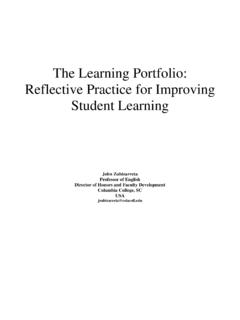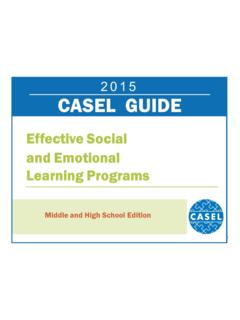Transcription of Practice guide to Chronologies - Care Inspectorate
1 Practice guide toChronologiesA Care Inspectorate guide , revising and replacing Practice guide : Chronologies published by the Social work Inspection Agency in 2010 COMMS-0117-213A guide to chronologiesThis guide updates and replaces the guide to Chronologies produced in 2010 by the former Social work Inspection Agency. The Care Inspectorate would like to express thanks and appreciation for the contribution made by many organisations and individuals to the preparation of the original guide . We would also like to thank those who helped us produce this new guide notably health and social care colleagues in Aberdeenshire, Ayrshire, Glasgow, Inverclyde and Introduction 2 Chronologies definition and purpose 3 Why are Chronologies useful to practitioners and managers?
2 4 The chronology: nine things to consider 61. The chronology as a tool in assessment and Practice 62. A chronology is not an assessment but part of assessment 83. A chronology is not an end in itself but a working tool which promotes engagement with people who use services 8 4. A chronology must be based on up-to-date, accurate case recording 95. A chronology should contain sufficient detail but not substitute for recording in the file 106. A chronology should be flexible detail collected may be increased if risk increases 10 7. The importance of review and analysis a chronology that is not reviewed regularly is of limited relevance 12 8.
3 Different types of chronology are needed for different reasons 13 9. Single agency and multi-agency Chronologies set different demands and expectations 14 Scrutiny findings 15 Conclusion 17 Appendix 1 Tayside chronology template 18 Appendix 2 Inverclyde good Practice example of a shared chronology 19 Appendix 3 References 22 IntroductionThe original version of this guide , published in 2010, set out to draw on practitioner experience in order to define Chronologies , explaining their uses and limitations.
4 It was in part a response to inspection findings, based on the reading of literally thousands of children s case records, which demonstrated considerable variation in the quality and application of April 2011, the Care Inspectorate has been responsible for inspecting standards of care in Scotland. Part of this role includes joint inspections of services for children and those for older people, reporting on the difference services are making to the lives of individuals within a local authority area. In the course of this work , we have continued to review Practice through reading significant numbers of case records held by services.
5 In doing so, the wide variation in the quality of Chronologies has continued to feature in our inspection findings, and the need for improvement in this important area of Practice persists. Significant developments in approaches to multi-disciplinary working and service delivery have had an impact on how Chronologies should be prepared and applied. For example, the implementation and consolidation of Getting it Right for Every Child1 means that the chronology is important not just in social work Practice , but amongst a wider range of professionals, including health visitors and teachers. Chronologies have equal relevance in work with adults, particularly in adult support and protection and criminal justice social work serious incident use the term Chronologies in the plural as there is latitude for various models and requirements of a chronology depending on the intended scope and format adopted.
6 However, the essential purpose of the chronology is to draw together important information and assist understanding, highlighting early indications of emerging patterns of recognise both the distinction, as well as the complex relationship, between assessment and chronology. Consequently, this is not a how to assess guide , but a recognition of the role of Chronologies as part of guide draws on our own scrutiny findings as well as those of different agencies, including the former Social work Inspection Agency (SWIA). It includes Practice examples from other UK published reports, including SWIA s 2010 guide to Chronologies .
7 Any identifying details, including names and places, within the Practice examples in this guide have been changed to preserve the anonymity of the people concerned. 21 : defintion and purposeIn our work with community planning partnerships, health and social care providers and other organisations, we continue to be asked about a working definition of a chronology and what one should look have come across many definitions of a chronology, for example: a list in date order of all the major changes and events in a person s life a chronology seeks to give a clear account of all significant events in a child s life to date, drawing upon the knowledge and information held by agencies involved with the child and , we consider the definition contained in the National Risk Framework2 to be comprehensive and helpful.
8 Although it makes explicit reference to children and families, it is a useful definition of a chronology for all groups. Chronologies provide a key link in the chain of understanding needs/risks, including the need for protection from harm. Setting out key events in sequential date order, they give a summary timeline of child and family circumstances [or those of an individual using adult services], patterns of behaviour and trends in lifestyle that may greatly assist any assessment and analysis. They are a logical, methodical and systematic means of organising, merging and helping make sense of information. They also help to highlight gaps and omitted details that require further exploration, investigation and assessment.
9 Within this definition, Chronologies may be compiled and used on a single or multi-agency basis and be developed to assist in current and ongoing assessment and risk management, or as an aid to reviews of past events. Despite being applied to a range of situations with different focus and purpose, the basic approach is essentially the same. The various approaches we describe in this guide can be applied to a range of situations, unless specifically stated otherwise. In this guide , we explore nine key characteristics of a chronology that should mean it is: a useful tool in assessment and Practice not an assessment, but part of assessment not an end in itself, rather a working tool which promotes engagement with people who use services accurate and relies on good, up-to-date case recording detailed enough but does not substitute for recording in the file flexible so that detail collected may be increased if risk increases reviewed and analysed a chronology which is not reviewed regularly is of limited relevance constructed differently according to different applications.
10 For example current work and examining historical events recognising that single-agency and multi-agency Chronologies set different demands and are Chronologies useful to practitioners and managers?In working to improve Practice that protects and enhances the lives of vulnerable children, young people and adults, one of the main issues for professionals has been the concept of risk. This guide does not explore the wider aspects of risk assessment in any detail3, but it does focus on Chronologies - a single important aspect of that process. A chronology is not an assessment, or an end in itself. It is a tool that professionals in a range of disciplines can use to help them understand what is happening in the life of a child or adult4.
